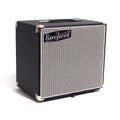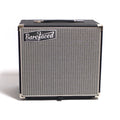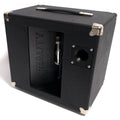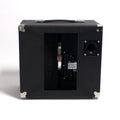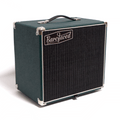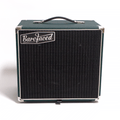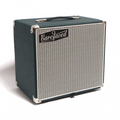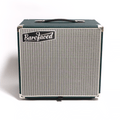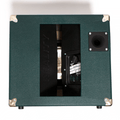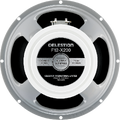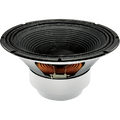Reality 112FR
Regular price
£399.00
£749.00
1 x 12" high accuracy loudspeaker cabinet for FRFR guitar and acoustic instruments - the ultimate solution for the amplification of both acoustic instruments and digitally modelled guitar sounds.
The requirements are the same - maximum accuracy, excellent audibility and controlled feedback. The only difference is that the output level for FRFR guitar in a rock band is usually much greater than the SPL for solo acoustic instruments - but this means that the Reality 112FR has the headroom to handle multiple acoustic instruments, vocals and even recorded music, making it a true gigging problem solver. Don't expect thunderous or massively deep lows (it isn't a bass cab) but it'll still give enough fatness for most full-range acoustic music.
Please skip the following if you just want to get to the specs or buy one - this is the story of why this cab is how it is:
This is not just a lightweight FRFR cab with classic styling - it's so much more! The Reality 112FR combines the might of Celestion's F12-X200 full-range live-response coaxial loudspeaker with an AVD enclosure and custom rear-firing tweeter / adjustable crossover, for the best possible reproduction of modelled/profiled tones.
Full Range Flat Response is not enough because this only describes steady state sound in one location. If you want "high accuracy" (and if you want to hear your digital magic then you really do) then you need the following:
- Accurate frequency response (aka FRFR)
- Accurate polar response
- Accurate transient response
- Accurate dynamic response
These are the four critical links of sound reproduction. You may not know it but you WILL hear the weakest link - it's no good having "perfect" FRFR if the dynamic, transient or polar response is poor because the human ear is very good at hearing the deficiencies, not the best aspects.
This isn't our first FRFR cab, we've been doing this since Barefaced started out making radical high accuracy bass cabs. The Big Baby 2 and Big Twin 2 are already being used by bassists, keyboardists and guitarists who need to hear the truth of their tone, some through amps like Kempers. But the BB2 and BT2 have so much more low frequency depth and output than any guitarist needs, making them bigger, heavier and more expensive. So this is our first guitar specific FRFR cab.
We found that the F12-X200's coaxial 12" driver and tweeter with integrated crossover made for a great-sounding, efficient and elegant starting point but how it was used made a big difference in the resulting sound.
An F12-X200 in a closed cab does a good job of frequency response but polar response isn't so good further off-axis. Transient response is good too but dynamic response is limited at lower frequencies like with louder or chunkier rhythm guitar work.
An F12-X200 in an open cab will do slightly better with polar response but worse frequency response; transient response will still be good but dynamic response will really struggle when playing louder chords, low notes, etc.
Another option is a speaker like the F12-X200 but without the coaxial tweeter (using DSP to boost the higher frequencies where the cone's treble output is dropping). This can achieve the target frequency response and transient response, the dynamic response will be similar although more demanding on amps (causing clipping at high SPL) but most importantly the polar response will be very poor at higher frequencies. However it's far less expensive than having a coaxial speaker with a crossover.
An F12-X200 in an AVD cab achieves good frequency, transient and dynamic response with much improved polar response up to the upper midrange / lower treble region. However testing showed that improving the polar response higher up made a huge difference in real world situations.
Adding a rear-firing tweeter with its own custom crossover to coherently combine with the AVD's ouput makes the polar response a near perfect figure 8, which gives you incredibly consistent tone wherever you're listening from. It's almost surreal to hear the improvement in audibility from turning up the tweeter control, considering that tweeter is firing away from you!
Specifications
| Dimensions (H x W x D) |
40cm x 45cm x 31cm 16" x 18" x 12" |
| Weight | 9.5kg / 21lbs passive - 10.5kg / 23lbs Activier |
| Enclosure design | AVD-8 |
| RMS power handling | 200 W |
| Nominal Impedance | 8 ohm |
| Speakers | Celestion F12-X200 + Eminence APT80 |
Features
- Barefaced AVD-8 enclosure for superior audibility, efficiency, power handling and truly accurate FRFR sound
- Celestion F12-X200 coaxial 12" 2-way driver - "Full Range Live Response"
- Rear-firing Eminence APT80 tweeter with custom 4th order crossover for radically improved clarity and tonal accuracy
- Independent adjustment of rear-firing tweeter for acoustic correction in real rooms on real gigs
- CNC machined dual-density plywood construction - better tone, gig tough, lower weight
- Single top strap handle - low profile to fit under amps; steel core, brackets, bolts and t-nuts for durablity; replaceable chrome trim for aesthetics; rubber sleeve for comfort; nylon washers to add friction and damping to ensure it remains rattle free
- Rubber feet on base - medium compound to damp vibration and add stability, tall enough to clear another handle if stacking
- Dual combi 1/4” + speakon sockets - use standard 1/4" leads, or have a locking speakon on the cab end which you can leave locked in place during transport
- Two grill cloth options: Deep Black or Bright Silver, with white piping
- Two tolex options: British Raging Green or Black In Black
- Custom tolex or grill cloth also available - extra cost, subject to availability, longer lead times likely.
Questions
What is an "FRFR" guitar cab and what is it for?
Full Range Flat Response guitar cabs were created so guitarists using modelling amps (as originally popularised by Line6) could hear the true sound of their modelled amp AND cabs - rather than hear the sound of the guitar speaker they were using. So the earliest FRFR cabs were simply little PA speakers as they have reasonably FRFR.
How is the Reality 112FR different?
At Barefaced we know that FRFR is not enough - we want TRUE SONIC ACCURACY. That means not only frequency response but also polar response, transient response and dynamic response. No other FRFR guitar cab on the market properly addresses all four aspects of tonal accuracy. In your bedroom, sitting right in front of the speaker you'll notice it feels more 3D, like you're surrounded by tone with so much presence without harshness - but take it to a rehearsal or gig and you, your bandmates and your audience will be blown away by how well they hear you, not louder but just THERE in the mix, wherever they're standing. And that creates a virtuous circle of performance, where the whole band ends up playing better and making better music. This is about making music, not just reproducing it like in the world of hi-fi!
How can this be a guitar cab and an acoustic instrument cab too?
FRFR guitar cabs do not sound like normal guitar cabs - a normal guitar speaker has limited bandwidth and large amounts of colouration (i.e. distortion) which filters the sound of an electric guitar through an amp giving the tones we all know and love. An FRFR speaker is fed a modelled sound like those that come from guitar speakers, so there is no need for the speaker to add another layer of colour. It's a bit like cooking - if the chef has already added the seasonings, herbs and spices and then you add the same again at the table it won't taste good. With modelled sound including speaker and cabinet emulation you want the actual loudspeaker to simply turn that electrical signal into acoustic sound without changing it, not adding more spice.
But if you want to hear an acoustic instrument louder then you need to put a mic or piezo pickup on it, maybe add some EQ to help and then turn that up loud with a clean amplifier through a really honest sounding speaker. And in an ideal world you want that speaker to be omnidirectional, filling the room with sound just like an acoustic guitar does - just like the Reality 112FR!
What is an AVD-8 enclosure and what does it do?
"Augmented Vent Diffractor - Figure 8" is the latest patented technology from Barefaced Audio. It improves low frequency efficiency and power handling whilst reducing distortion, generates rear-firing midrange output with even response and broad dispersion and integrates a phase coherent rear tweeter. The end result is highly accurate response from both front and rear of the loudspeaker, giving incredibly "real" live sound and outstanding resistance to the problems caused by noisy bandmates or difficult room acoustics.
How does the AVD-8 enclosure work?
This may take a while to get your head around! At lower frequencies the slot and horn acts as a Helmholtz resonator, like a reflex port. Above these frequencies the slot allows midrange and treble frequencies through, diffracting them sideways for improved dispersion, with the horn panels improving acoustic coupling with the room.
If the AVD worked like a horn then output through most of the midrange and all of the treble bandwidth would be minimal (because in a horn the air masses in the coupling chamber, throat and horn act as an acoustic inductance with a low pass effect). Fortunately the AVD system instead allows good response into the lower treble region but that leaves a few octaves missing from the rearwards output for many guitar sounds.
The AVD-8 system therefore has a high output low distortion tweeter mounted on the rear baffle This tweeter is crossed over where the 12" driver's rearward output rolls off, which is over an octave lower than its forwards output. The tweeter thus takes over the rearward output throughout the whole treble bandwidth, which is only possible due to the very steep crossover slope protecting the diaphragm from over excursion.
One other clear acoustic benefit of the AVD-8 enclosure is in how it controls internal reflections and standing waves compared to a conventional cuboid-shaped guitar cab. The angled AVD panels and asymmetric baffle measurably reduce the amount of internally reflected sound that manages to escape through the cone interfering with the original tone, often causing conventional guitar cabs to literally sound "boxy".
How does the near-omnidirectional figure 8 response affect both acoustic and electric feedback?
One of the almost magical abilities of the AVD-8 enclosure is that to your ears it has very broad dispersion but to your guitar it has much more controlled dispersion. This is due to the psycho-acoustic phenomenon known as "precedence effect", whereby the brain combines near-identical sounds even if they're coming from different locations, as long as the delay between the two sounds is less than ~50ms. Consequently your brain hears the rear output as it reflects off room boundaries and miraculously combines it with the front output, hugely improving audibility, but that delayed sound has a less strong effect in acoustically generating guitar feedback. No conventional cab is as easy for lead guitarists to coax singing feedback from.
Obviously with acoustic instruments you don't "play" with feedback like with an electric guitar but feedback is certainly a big issue. If you crank your acoustic guitar, violin, cello, etc up super loud through the Reality 112FR just like a wailing lead guitarist then you will run into the usual feedback problems and have to flip phase, use notch filters etc. But if you're not going so crazy and just turning up normal acoustic gig loud then the narrower forwards dispersion and broader rearwards dispersion will result in greater feedback resistance at a given level of perceived loudness than any conventional cab.
What does the tweeter control do and what is it for?
The tweeter control independently adjusts the level of the rear-firing tweeter - note that this tweeter is crossed over very low, as much as two octaves below where a tweeter on a typical guitar FRFR cab might be, so it has a big sonic affect as it deals with the full treble bandwidth and what many guitarists will also consider their upper midrange tone. This gives a unique dimension of acoustic control, so in a very bright sounding room with lots of hard surfaces you may keep it turned down low whilst in a more acoustically dead room you'll turn it up more.
This is particularly valuable when playing smaller venues where your guitar cab is providing the house guitar sound or the bleed from the stage is loud out front, especially in terms of how the sound changes between soundcheck in an empty room and a packed gig - humans are very efficient acoustic absorbers. Simply turn up the tweeter control and bring that clarity and liveliness back.
With acoustic instruments of all kinds, turning up the rear-firing tweeter will not just add audibility but more importantly make the sound far more 'acoustic'. Instruments acoustically radiate sound in all directions and that is one of the main reasons why the vibe and character of an unplugged acoustic is so different to hearing it through a typical "acoustic" amp.
What is "CNC machined dual-density plywood" construction?
In 2008 Barefaced pioneered the use of unconventional plywood, bracing and assembly techniques within the guitar and bass amp industry. For more than a decade we've continued to develop our enclosure designs, for the best possible sound through management of internal reflections for clear detailed mids and highs, and rigid non-resonant enclosures for tight controlled lows. This method of extensive bracing and calculated reinforcement allows us to make the cabinets incredibly low in weight but tough enough to gig for a lifetime. Since 2012 they've been precisely machined using our own CNC mill and then hand assembled in our Brighton factory.
Customer feedback
17/12/25 - Big Baby 2 - UK
Hello I own a Barefaced Big Baby 2 (Gen 3) which I absolutely love so thank you!
I’m just wondering if it would be ok to pair with a Seymour Duncan power stage and use with a guitar/quad cortex instead of (or as well as) bass?
Thanks
Mal
--------------------------------------------------------------------------------------
Hi Mal,
Yes, that'll work very well! Glad you're loving it - spread the word!
Best regards,
Alex
12/12/25 - Big Baby 3 + Big Twin 3 - USA
Man I know I’ve left a few reviews and comments but it’s been about 3 years since I’ve gotten my Big Baby 3 and my Big Twin 3 and I am in love with these cabs!
I am at music practice and decided to crank up the Big Twin 3 and unplug from the front of house. Our church seats about 600 on the bottom and it was loud enough to make me nauseous (not exasperating) 😂 but not distorted at all! I tune down my 5 a whole step and the open A... The low bass is unlike any other cab I’ve ever heard! So tight! My wife was on the other side of the church about 100 feet away and it was rattling her chest 😂
2 12"s and 54 pounds 🤦 doesn’t make sense. My Big Baby 3 also is a beast! Good job Alex and the team! If you’re on the fence and think it’s a lot of money 😂 trust me it will be the last can you’ll ever need.
Corey
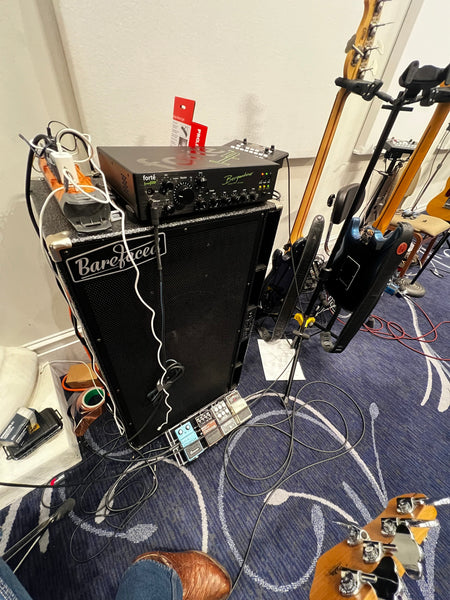
05/12/25 - Big Baby 3 - Canada
Received my big baby yesterday, all good. Had a quick play around and no problems, sounds great! The response is so fast, I wasn’t quite expecting that.
02/12/25 - Big 24 - USA
My Big 24 arrived safe and sound yesterday. And it sounds incredible. I’m blown away by how something small relative to a traditional 810 fridge can sound so huge and monstrous. So huge yet reactive to my playing. My current band is a metallic hardcore project that tunes to drop B flat. The Big 24 handles the low tuning so well. During our initial gear talk, I failed to mention how low I tuned, but I’m guessing by the way the Big 24 handles the big string, it’s the best cab in your lineup for lower tunings? I’ll be grabbing my standard-tuned bass today and can’t wait to hear how good it sounds again. Since I’m used to sealed Ampeg cabs, I was a little worried that it’d take getting used to hearing a more modern cab, wondering if I should have gone with your Six10 instead. But after yesterday, I think your 12 speakers can do anything a bass player would want. With an SVT, P bass, and a couple of dirt pedals, the Big 24 is the perfect canvas for creating tones that fit in with the brands of yesteryear. I’m confident it would sound great with modern tones, too, if that was my style.
Thank you, Isaac, Alex, and the whole team at Barefaced. I’m 34 and have been playing bass since I was 12. Playing through your cab yesterday was one of my most memorable moments in 22 years of playing.
Levi
27/11/25 - Big Baby 2 - UK
I have a pair of Big Baby 2s, driven by a TC RH750 amp with my Warwick Corvette active. I am oftem complimented on my sound - even by other bass players who only use tube amps!
Greg
26/11/25 - Activier One10T - USA
Great also for cello!!
Andrew
24/11/25 - Big Baby 3 - USA
Thank you for the fantastic cab! This thing is a beast.
Luke
12/11/25 - Big Baby 2 - USA
I picked up a BB2 in ’17, and another in ’20. Nothing urgent but I have a couple of questions when you have a chance.
Very pleased with my rig and sound which includes a Kemper, and a Matrix GT2000Fx, main bass is a Roscoe SKB3006 and have a LG3006 Custom on the way.
I figured I better start looking at backups in case something or other failed on me.
Question 1: The BB3 looks great, as does the Super 24. I’m running the Kemper/Matrix stereo. I usually play at fairly low volumes, but I’ve become very attached to the fullness of the huge headroom (for reference, I typically have band members asking me to turn up).
My thoughts are I would add a new cab and reserve the old BB2 as a backup. Would you recommend the BB3 or Super 24, or maybe a toss up?
Question 2: Related to 1 to a degree. Also, very happy with the Matrix, 1000 watts per side at 4 ohms, and super light aluminum, so thought of grabbing a 2nd eventually (or asap if it were to fail), but it has been discontinued. Even grabbing 2 GT1000’s looks dicey. Do you have any recommendations for a replacement? I should add, I’m 61 so lightweight is almost as important as the sound. Have not found anything yet that is as powerful and light as the GT2000. A Crown XLS 2502 looks ok, a little less power than the Matrix, a little heavier, guessing the sound may not be as high quality as the Matrix? Some comparable offerings from QSC, Crest, Lab Gruppen. Even looked at a Demeter 1600HD, which seems great except it has tubes, so goes against the idea of keeping the amp and speakers “pure” so the Kemper can do its thing. Also, wondering if I should even look at a more powerful amp if I should go with the Super 24 to try and get close to its 1,200 watts capacity?
Thank you for your time and the great cabs
Jeff
--------------------------------------------------------------------------------------
Hi Jeff,
Are you wanting a solely back-up or an alternate kind of thing?
In terms of amps it depends on how much of a hurry you're in - we've been delayed on the amp front with having to relocate the business but once our first amp is out the future models should follow fairly quickly.
I trust the rig is sounding great!
Best regards,
Alex
--------------------------------------------------------------------------------------
Thanks Alex,
05/11/25 - Reality 112FR - UK
Hi Alex,
Thoroughly enjoying the Reality!
I am now considering a Reformer with a guitar driver for two jobs: to act as a second cab powered by the Activier (with signal routing so the IR/Cab sim is bypassed for the second input etc), and as a main speaker for a 100w guitar amp. I am thinking of the Celestion Redback, because of the power handling and because I prefer a darker sound.
My existing cab, Orange 1x12 with V30 has some harsh high mid frequencies (I think) that I just can't dial out and have the tone that I like. I have watched your YT vids on the Redback, and I do like the sound.
Main types of tones are clean/teensiest edge of breakup to higher gain rock.
Just wanted to check if you think the Reformer with Redback suits the bill? Can you build this as an 8 ohm driver as well?
Thanks!
Jules
--------------------------------------------------------------------------------------
Hi Jules,
Glad you're enjoying the Reality!
This sounds like a great plan!
We're big fans of the Redback - I think it's one of those drivers that sounds MILES better in an AVD cab because the big voice coil and stiffer cone (for the high power handling) give it narrower dispersion in a normal cab. The AVD fixes that and lets it really sing in the mids.
Best regards,
Alex
07/11/25 - Big Baby 2 - Mauritius
I have 2 Big Baby's already (best cabs I ever had) but I have a new weekly gig where I must go up 2 flights of stairs. We don’t play loud up there so the Super Mini T will be great.
03/11/25 - Reality 112FR (Activier 2) - UK
The cab was absolutely outstanding on the road. I have been happy with it for home use for a while, but getting it up to gig volume in medium sized rooms was a revelation. The uniformity of the sound at different points in the room is an absolute gamechanger, and the clarity and accuracy is a league above my previous cab. Everyone we showed it to was blown away and I'd like another passive unit to complete a stereo rig.
Glen
31/10/25 - Big Baby 3 - USA
Aloha my friends at Barefaced! It’s been a few years since I’ve purchased my BB3 and it has amazed everyone with stunning clarity and SPL. On every stage, large or small I get the same reaction. Upon the first note of my bass, the band members turn their heads with curiosity and a big smile while the sound engineers always ask me “what is that”? It’s awesome! But you know that already…
Anthony
29/10/25 - Big Baby 3 - USA
ALCHEMY, I SAY! Seriously, how do you get so much true volume (not just loud, the sound is encompassing) out of your cabs?! Love everything you guys make. Twin BB3s 🤘✌️
David
24/10/25 - Big Twin 3 - USA
I own the Big Twin 3, and it's amazing! I gig a lot and have some important shows coming up where I will need the smaller cabinet, hence my purchase of the Big Baby 3.
22/10/25 - Big Baby 2 + Big Twin 3 - USA
My Big Twin and Big Baby have covered every single gig since I’ve purchased them flawlessly…
Even use them for keyboards!!!!
Grateful,
Steve
16/10/25 - Big Twin 3 - USA
My cab arrived today, Oct 16!!
Wow, great timing and the cab is fantastic.
Thank you for your efforts and service on my behalf. I would love to thank your whole team for making this happen.
Can’t wait to perform with it in 9 days 😁
Thanks so much,
All the best to all of you,
Bill
08/10/25 - Big 24 / Six10 - USA
Hello,
I am a proud owner of a Big 24 and a Six10 and they are both amazing. I use the Big 24 as a huge FRFR for my function band work with Quad Cortex into the AG500 (bypassing the preamp) and the Six10 for my work in an original band with analog pedals and either an SVT or a Jad Freer Sisma. Having lived and played on both cabinets for a while, (and putting aside the very different applications I use them for) on balance, I prefer the sound of the Six10. If forced to choose only one cabinet for any application, I would go Six10. That being said the Six10 and SVT are getting to be a bit too much to load in and out every night. I am looking to downsize. The Sisma has me sorted for downsizing amps and is a worthy 9lbs replacement for the SVT. For cabinets, I have a strong inclination to go with a Three10. Would you agree? If not, what would you recommend? Assuming that you agree with that, I also predict that once I start loading in a Three10 to shows, the Big24 may also start to feel a bit big to lug around to function work. So my second question is, if I am likely headed toward a world with one cabinet for both original and function work, would you recommend Three10 or Three10T?
Thanks in advance for your time and help with this.
Best,
Robert
--------------------------------------------------------------------------------------
Hi Robert,
If you use the extended highs on the Big 24 then definitely go with the Three10T if you want to cover that realm too. Obviously the SVT is wider than the Three10, so bear that in mind from an aesthetic point of view.
Best regards,
Alex
04/10/25 - Big Twin 3 - USA
Playing a tribute festival this weekend, and enjoying the Big Twin 🤘
Randy
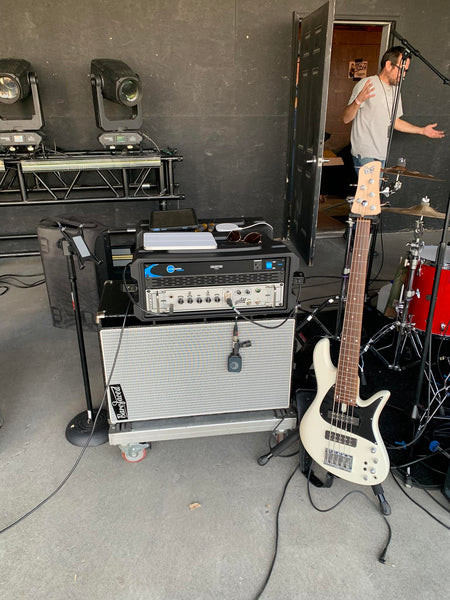
06/10/25 - Activier Reality 112FR - Spain
I just received the Reality and have to tell you that after trying a little bit I'm amazed by the clarity and dynamics of cabinet. I like it very much and it's very quiet something I also appreciate a lot.
Today I'm taking it to my first gig so I'll see how it behaves in a stage.
I'll let you know how it goes
Thank you very much
Marc
02/09/25 - Activier Reality 112FR - USA
I have had mine (two amp version) for a few weeks now. It is mind blowing how good it is. Even had the drummer in my band saying how good it sounds!
Jules
17/09/25 - Big Baby 3 - UK
First off, just to say how much I’m enjoying my two BB3 cabs (order ref #5439).
At some gigs however, the stage has been so small that I’m literally backing up against them, and on some gigs on a steamship, I’m not taking any cabs, just my amp straight to desk and a monitor signal to a floor monitor. The bass therefore does NOT sound great for me.
So basically I’m wondering if a “tilt back” or “monitor wedge shaped”, version would be an option for a one10 or maybe a super mini?
I kinda get the feeling that tooling etc costs might make it prohibitive, but thought I should ask!
Kind regards,
Stuart
--------------------------------------------------------------------------------------
Hi Stuart,
Glad you're enjoying them!
We've just moved premises (this is literally the first hour of all of us being in the new space) and we now have more space so this does open up quite a few options for customisations like this.
Best regards,
Alex
02/05/25 - Big Baby 3 - USA
I hope this message finds you well, and you're enjoying the day -
I am thoroughly enjoying my new BB3 but had some general questions in regards to decoupling... Are there any dos & do nots regarding this? I feel like the web seems to give vague and not consistent information, and this seems right up your (and Alex's) alley. Perhaps this could be another informative video- I feel like after decades of playing, I have learned a great deal from watching many of the Barefaced videos online.
Oh, also waiting patiently for information about a Barefaced bass amplifier- hints are welcome! Thank you in advance for your time, and I hope to hear back soon!
Sincerely,
Sean
--------------------------------------------------------------------------------------
Hi Sean,
Glad you're enjoying the BB3!
I should make a video about coupling etc. Amp is progressing!
Best regards,
Alex
14/06/25 - Big 24 - USA
Hello,
05/08/25 - Big Baby 2 / Big Twin 2 / LF1400 (discontinued) - UK
Hope all is good in Brighton. Still promoting Barefaced here in Cornwall.
Question:
I use a Dynacord TGX10 amp. It runs Sub aux at 1250W into 8 Ohms which I have been doing passively whilst sorting LF1400 amp fix. It will however will deliver 2500W into 4 Ohms. I like using a singe front facing Sub stage centre, plus easy transport.
What is the current speaker in the LF1400?
Would it be worth upgrading to Fane 18XL1600 (4 Ohm) or 18XL2000 (8 Ohm). Would the cab design handle it and would they fit?
I run 2 channels F/H L + R into 2 x BB2 and add 2 x BT2 in parallel for bigger gigs. Did a 800 audience Country Festival at weekend. Sounded great.
Martin
-----------------------------------------------------------------------------------------
Hi Martin,
Rig looks epic!
This is the driver in the LF1400: https://faitalpro.com/
It's only available as 4 or 8 ohms and we used the 8 ohm version so we could bridge the power amp module.
I don't think you'll gain anything from changing the driver, the current one is really good - and I don't know if those others will fit and work well with the cab design.
Best regards,
Alex
12/08/25 - Big Twin 3 - USA
I have loved it! It plays fantastic.
Tyler
11/08/25 - Big Baby 3 - USA
So I got the cab and it is freaking SPECTACULAR man!!!!!
I love it! (Also I use too many exclamation points!!!)
It arrived safely and it works perfectly for my needs.
I wish you all the best and you’ll probably hear from me at some point soon when I convince myself I need yet another bass cab.
Mike
07/08/25 - Activier Reality 112FR - UK
Absolutely stunning cab/amp may I say
Danny Page
24/07/25 - Big Twin 3 - USA
Hello.
I recently got my Big Twin 3 and I couldn't be happier. I will be trying it out today for the first time and I am extremely excited.
I did want to ask, do you have any covers for these?
Al
--------------------------------------------------------------------------------------
We certainly do!
https://barefacedaudio.com/products/cover-for-big-twin?_pos=1&_sid=c7b12ab1e&_ss=r
For future reference, here is how to add a cover when purchasing the cab from us:

22/07/25 - Big Baby 3 - UK
Hi Isaac, Alex and Team,
20/07/25 - Big Twin 3 - USA
I thought y’all might get some enjoyment out of looking at the best of British engineering both in the past and current.
Scott
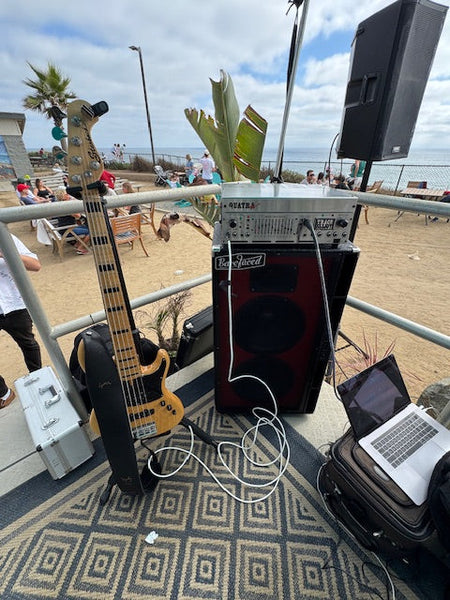
19/07/25 - Big Twin 3 - UK
Just a thank you for your advice after my request for info on your incredible bass cabs.
Although I didn’t by one new from you as planned I did get a beautiful Big Twin 3 pre-loved. What a monster for such a light weight cab. Clarity is wonderful and punch is awesome. For the first time I can hear a big difference between multiple amps. I will be looking in the future for a Big Baby 3 for smaller gigs. I am very proud to be an owner of your wonderful products.
Continue the great work
Wayne
21/07/25 - Big Twin 3 - USA
It's about to go (low) down 🤘
Shane
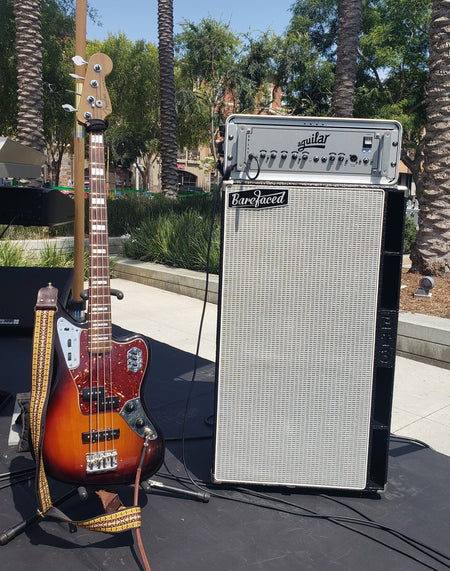
11/07/25 - Activier Reality 112FR - USA
Well, my friends, you f*%king did it! I’ve installed the new Activier module today, and am very happy to report that your new design has essentially solved the EMI problem! The unit is now quite amazingly quiet, as you have proudly and rightly advertised.
EMI is gone, and the hiss is much much lower - overall, this is a much improved circuit layout if you ask me.
I would like to thank you for sticking with me as we worked together to improve the situation. You took me seriously and I’d like to think I did my part in providing good, actionable data.
How this was handled speaks quite a lot to your values as a company and something I will be sure to trumpet to those who ask my opinion. This Reality with Activier, I believe, is such a fantastic solution for us guitar modeling enthusiasts. I’ve played the Fender FR-12, which seems to be the king in everybody’s mind, and this one is just better all around. It’s a great bit of engineering, and the cabinet design itself has always been a game changer for me.
I believe that for the first time since I bought this product way back when, I’m truly experiencing what you want me to experience.
Thanks again to everyone at Barefaced, and please be sure that others on the team see this email. You've made my day.
CJ
11/07/25 - Activier Reality 112FR - USA
27/06/25 - Big Baby 3 - CZ
I must say, that the Big Baby 3 is wonderful speaker, it could play almost open air (in an open tent) with a little band (drums, 2 guitars, singing, bass and piano) even when powered by 60W Mark Bass Micro Mark
:o) Congratulations!
Daniel
02/06/25 - Big Baby 2 - UK
I've recently moved on from a 15 year stint with a band and started a new project, in which we've also decided to try using IEMs and going amp free. That means that the Big Baby 2s that have been sounding fabulous in my bass rig for the last 5 years would have been unused, unless 🤔...
Jools
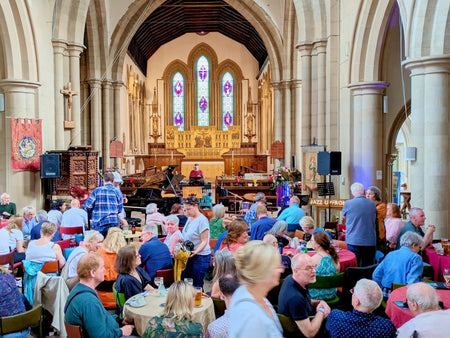
25/05/25 - Big Twin 2 + 3 - Denmark
Sold out Vega in Copenhagen tonight. One bass and one synth\
Mads
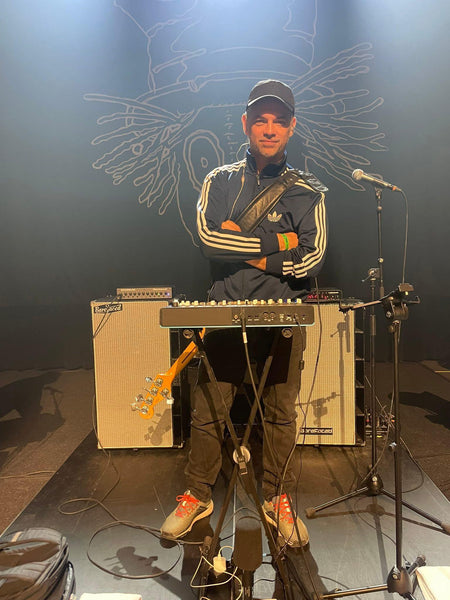
04/04/25 - Big Baby 2 - USA
2x Big Baby 2 + GK MB800 doin' the business. Outdoors, not in the PA but sounds like i'm in the PA.
Alan
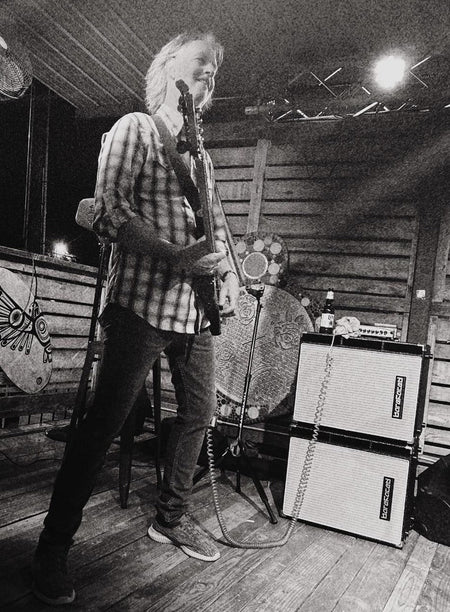
28/05/25 - Big Baby 2 - UK
I own a Barefaced Big Baby 2 bass cabinet provided to me by a good friend. It has proved nothing short of excellent driven by an Eich T900 which is capable of giving 600W into the Big Baby 8ohms nominal resistance which is ample for pretty much any gig.
However, it is a bit ‘overkill’ for practice and rehearsal purposes.
I was thinking, therefore, of adding a Super Mini which when put with the Big Baby 2 would, with 4ohm resistance, make use of the Eich’s full power where necessary and provide a more portable cab for practice purposes etc.
I see from the information available on your website that you recommend pairing a Super Mini cab and a Big Baby 3, so my initial query is; will the Super Mini work as well with the Big Baby 2?
Mike
--------------------------------------------------------------------------------------
30/04/25 - Big Baby 3 - Italy
Hey Alex et al!
27/04/25 - Big Twin 3 - USA
I’ve had my Big Twin 3 for over a year and absolutely love it! Thanks guys!
23/04/25 - Big Baby 2 - UK
Well it was sounding nice and well balanced at the rehearsal last night.
Simon
04/04/25 - Big Twin 3 - UK
I picked up this BT2 on Wednesday and let it stretch its legs in the studio last night with the band.
Ibanez BTB805MS
Ibanez PTEQ
HX Stomp
Warwick LWA1000
I was a bit of a sceptic - hadn’t seen much written about hard rock/metal through these cabs - but I’m convinced it can do anything you want.
James
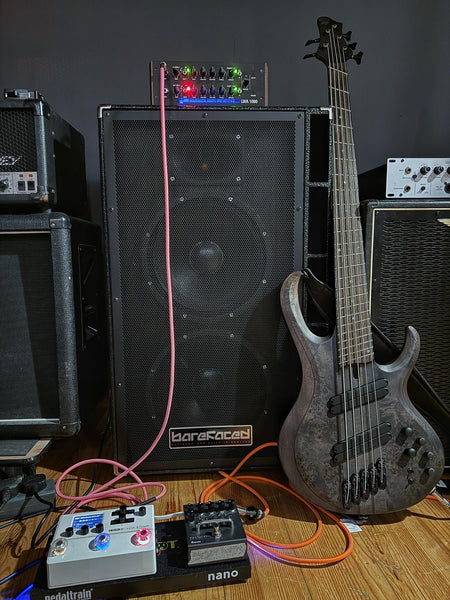
09/04/25 - Big Baby 3 - Canada
These two little fellas showed up today. Incredible.
Ian
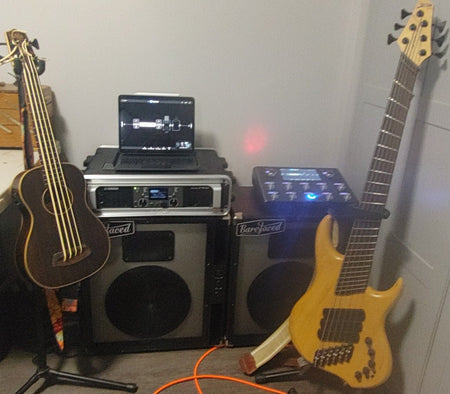
22/03/25 - Big Baby 3 + Big Twin 3 - Germany
I just finished a little amp and cab shootout. We compared my BB3 with a BT3 and a Rheingold BA112.
The Barefaced speakers outshined the Rheingold by far (especially in the low end department)
Mischa
22/03/25 - Big Baby 3 - USA
Mezmerized...
Sean
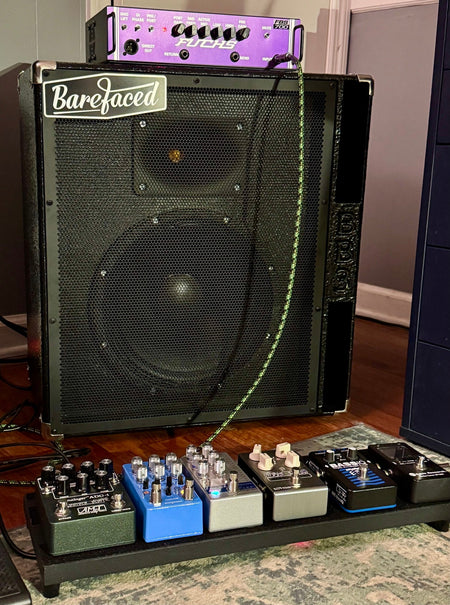
05/11/25 - Reality 112FR - UK
Hi Alex,
Thoroughly enjoying the Reality!
I am now considering a Reformer with a guitar driver for two jobs: to act as a second cab powered by the Activier (with signal routing so the IR/Cab sim is bypassed for the second input etc), and as a main speaker for a 100w guitar amp. I am thinking of the Celestion Redback, because of the power handling and because I prefer a darker sound.
My existing cab, Orange 1x12 with V30 has some harsh high mid frequencies (I think) that I just can't dial out and have the tone that I like. I have watched your YT vids on the Redback, and I do like the sound.
Main types of tones are clean/teensiest edge of breakup to higher gain rock.
Just wanted to check if you think the Reformer with Redback suits the bill? Can you build this as an 8 ohm driver as well?
Thanks!
Jules
--------------------------------------------------------------------------------------
Hi Jules,
Glad you're enjoying the Reality!
This sounds like a great plan!
We're big fans of the Redback - I think it's one of those drivers that sounds MILES better in an AVD cab because the big voice coil and stiffer cone (for the high power handling) give it narrower dispersion in a normal cab. The AVD fixes that and lets it really sing in the mids.
Best regards,
Alex
03/11/25 - Reality 112FR (Activier 2) - UK
The cab was absolutely outstanding on the road. I have been happy with it for home use for a while, but getting it up to gig volume in medium sized rooms was a revelation. The uniformity of the sound at different points in the room is an absolute gamechanger, and the clarity and accuracy is a league above my previous cab. Everyone we showed it to was blown away and I'd like another passive unit to complete a stereo rig.
Glen
06/10/25 - Activier Reality 112FR - Spain
I just received the Reality and have to tell you that after trying a little bit I'm amazed by the clarity and dynamics of cabinet. I like it very much and it's very quiet something I also appreciate a lot.
Today I'm taking it to my first gig so I'll see how it behaves in a stage.
I'll let you know how it goes
Thank you very much
Marc
02/09/25 - Activier Reality 112FR - USA
I have had mine (two amp version) for a few weeks now. It is mind blowing how good it is. Even had the drummer in my band saying how good it sounds!
Jules
07/08/25 - Activier Reality 112FR - UK
Absolutely stunning cab/amp may I say
Danny Page
11/07/25 - Activier Reality 112FR - USA
Well, my friends, you f*%king did it! I’ve installed the new Activier module today, and am very happy to report that your new design has essentially solved the EMI problem! The unit is now quite amazingly quiet, as you have proudly and rightly advertised.
EMI is gone, and the hiss is much much lower - overall, this is a much improved circuit layout if you ask me.
I would like to thank you for sticking with me as we worked together to improve the situation. You took me seriously and I’d like to think I did my part in providing good, actionable data.
How this was handled speaks quite a lot to your values as a company and something I will be sure to trumpet to those who ask my opinion. This Reality with Activier, I believe, is such a fantastic solution for us guitar modeling enthusiasts. I’ve played the Fender FR-12, which seems to be the king in everybody’s mind, and this one is just better all around. It’s a great bit of engineering, and the cabinet design itself has always been a game changer for me.
I believe that for the first time since I bought this product way back when, I’m truly experiencing what you want me to experience.
Thanks again to everyone at Barefaced, and please be sure that others on the team see this email. You've made my day.
CJ
11/07/25 - Activier Reality 112FR - USA

















